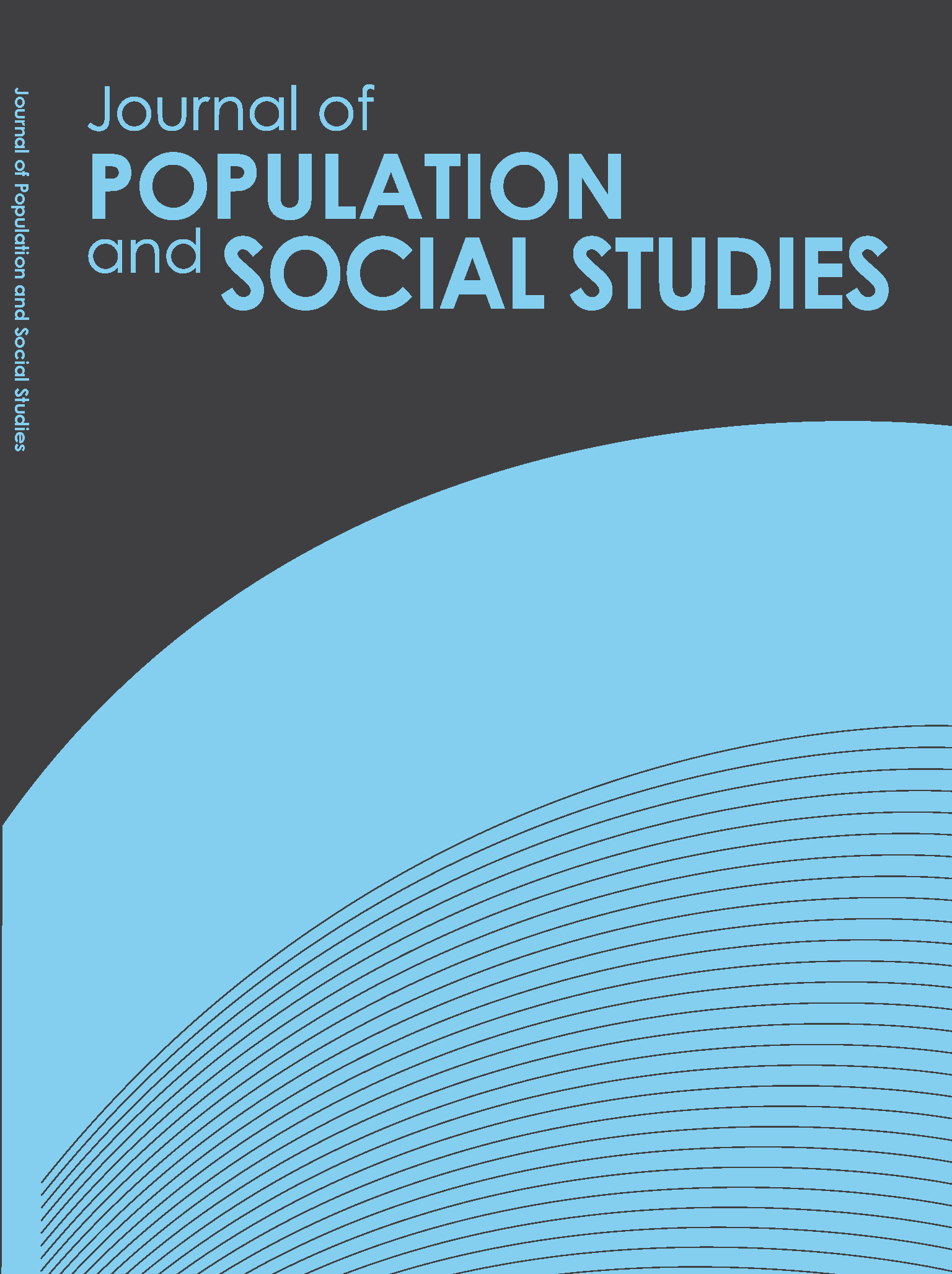Influence of Parental Education on Nuptial Behavior: An analysis of Hindu Community in India
Main Article Content
Abstract
This study examines how the Hindu community, which has a long history of arranged marriages rooted in caste endogamy, has responded to popular schemas of developmental idealism (role of education in changing societal norm is one of them). The paper analyzes the often-cited argument that education substantially influences the process of spouse selection. The nationally representative (n=10,486) data of the second round of the Indian Human Development Survey (2011-2012) was analyzed to generate findings which suggested higher age at marriage and highly educated brides tend to arrange their own marriages. Exposure to education, and the fact parents are increasingly seeking the consent of their daughters in choosing their future husband play a role here. Specifically, multivariate analysis shows parents’ (particularly the mother of the bride) education plays a part in their willingness to obtain consent of their daughter in selecting their future spouse. This culminates either in self-choice marriages or jointly arranged marriages. Findings also showed the education level of bride is not significantly associated with their choice of mate.
Article Details
References
• Aengst, J. (2014). Adolescent movements: Dating, elopements, and youth policing in Ladakh, India. Ethnos, 79(5), 630-649.
• Aldridge, D.P. (1973). The changing nature of interracial marriage in Georgia: A research note. Journal of Marriage and Family, 35(4), 641-642.
• Allendorf, K. (2013). Schemas of marital change: From arranged marriages to eloping for love. Journal of Marriage and Family, 75(2), 453-469.
• Allendorf, K., & Pandian, R.K. (2016). The decline of arranged marriage? Marital change and continuity in India. Population and development review, 42(3), 435-464.
• Arends-Toth, J., & Vijver FJ, V.D. (2009). Cultural differences in family, marital, and gender-role values among immigrants and majority members in the Netherlands. International Journal of Psychology, 44(3), 161-169.
• Blossfeld, H.P., & Huinink, J. (1991). Human capital investments or norms of role transition? How women's schooling and career affect the process of family formation (Vol. 97). University of Chicago Press.
• Buttenheim, A.M., & Nobles, J. (2009). Ethnic diversity, traditional norms, and marriage behaviour in Indonesia. Population Studies, 63(3), 277-294.
• Caldwell, J.C., Caldwell, P., Caldwell B.K., & Pieris, J. (1998). The construction of adolescence in a changing world: implications for sexuality, reproduction, and marriage. Studies in family planning, 137-153.
• Chowdhry, P. (2007). Contentious marriages: Eloping couples: gender, caste and patriarchy in Northern India, Delhi. Oxford University Press.
• Corwin, L.A. (1977). Caste, class and the love-marriage: Social change in India. Journal of Marriage and the Family, 823-831.
• Easterlin, R.A. (1980). Birth and Fortune. New York: Basic Books.
• Fuller, C.J., & Narasimhan, H. (2008). Companionate marriage in India: the changing marriage system in a middle-class Brahman subcaste. Journal of the Royal Anthropological Institute, 14(4), 736-754.
• Ghimire, D.J., Axinn, W.G., Yabiku, S.T., & Thornton, A. (2006). Social change, premarital nonfamily experience, and spouse choice in an arranged marriage society. American Journal of Sociology, 111, 1181-1218.
• Goli, S., Singh, D., & Sekher, T.V. (2013). Exploring the myth of mixed marriages in India: Evidence from a nation-wide survey. Journal of comparative family studies, 193-206.
• Hitlin, S. (2006). Parental Influence of Children's Values Aspirations; Bridging two theoreis of social class and socialization. Sociological Perspectives, 49, 24-49.
• Hoem, J.M., & Kostova, D. (2008). Early traces of the second demographic transition in Bulgaria: A joint analysis of marital and non-marital union formation, 1960-2004. Population Studies, 62(3), 259-271.
• Jauregui, B., & McGuinness, T. (2003). Inter-community marriage and social change in contemporary India: Hybridity, selectivity and transnational flows. South Asia: Journal of South Asian Studies, 26(1), 71-85.
• Jejeebhoy, S.J., & Halli, S.S. (2005). The changing transitions to adulthood in developing countries: Selected studies. The changing transitions to adulthood in developing countries: Selected studies, 172-199.
• Kolenda, P. (1987). Regional differences in family structure in India. Jaipur: Rawat Publications.
• Mody, P. (2002). Love and the law: Love-marriage in Delhi. Modern Asian Studies, 36(1), 223-256.
• Mody, P. (2008). The intimate state: Love-marriage and the law in Delhi. Routledge.
• Nauck, B. & Tabuchi, R. (2012). One or two pathways to individual modernity? The effects of education on family formation among women in Japan and Germany. Vienna yearbook of population research, 49-76.
• Nedoluzhko, L. & Agadjanian, V. (2015). Between tradition and modernity: Marriage dynamics in Kyrgyzstan. Demography, 52(3), 861-882.
• Netting, N.S. (2010). Marital ideoscapes in 21st-century India: Creative combinations of love and responsibility. Journal of Family Issues, 31(6), 707-726.
• Raymore, L.A., Barber, B.L., & Eccles, J.S. (2001). Leaving home, attending college, partnership and parenthood: The role of life transition events in leisure pattern stability from adolescence to young adulthood. Journal of Youth and Adolescence, 30(2), 197-223.
• Registrar General (2011). Provisional Population Totals-India Data Sheet. Retrieved from Office of Registrar General Census Comissioner, India, Indian Census Bureau : http://censusindia.gov.in/
• Saroja, K. (1999). Intercaste marriage and social dynamics in India: A critique. Indian Journal of Social Work, 60, 183-192.
• Schroder, C. (2006). Cohabitation in Italy: Do parents matter. Genus, 53-85.
• Thornton, A. (2001). The developmental paradigm, reading history sideways, and family change. Demography, 38(4), 449-465.
• Upadhyay, S.K. & Gupta, P. (2013). Marriage, process and preparedness among youth: Insight from youth in India. XXVII International Population Conference.
• Vijayalaxmi, A.H.M., & Saroja, K. (1992). Changes in kinship adjustment of mixed and intracaste married working women. International Journal of Sociology of the Family, 61-68.
• Wiik, K.A. (2008). ‘You'd better wait!’—socio-economic background and timing of first marriage versus first cohabitation. European Sociological Review, 25(2), 139-153.
• Yadav, B. (2009). Khap panchayats: Stealing freedom? Economic and Political Weekly, 16-19.


